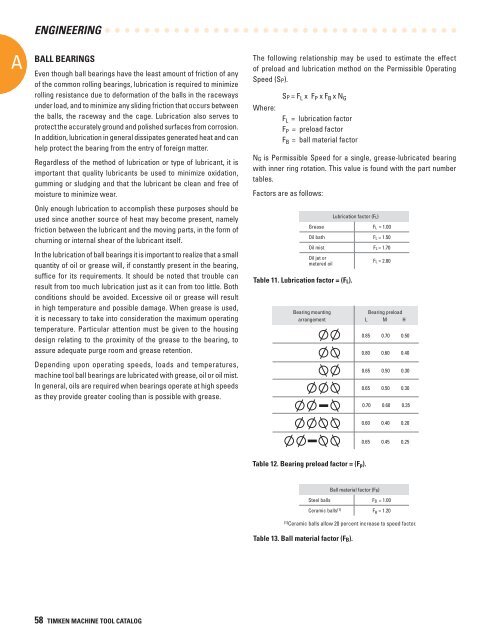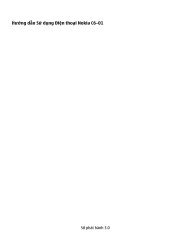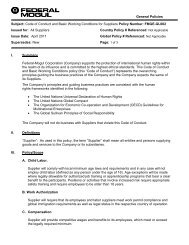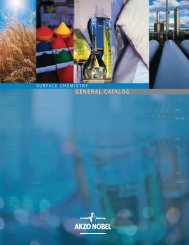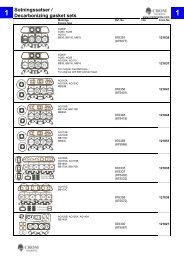Create successful ePaper yourself
Turn your PDF publications into a flip-book with our unique Google optimized e-Paper software.
A<br />
ENGINEERING<br />
BALL BEARINGS<br />
Even though ball bearings have the least amount of friction of any<br />
of the common rolling bearings, lubrication is required to minimize<br />
rolling resistance due to de<strong>for</strong>mation of the balls in the raceways<br />
under load, and to minimize any sliding friction that occurs between<br />
the balls, the raceway and the cage. Lubrication also serves to<br />
protect the accurately ground and polished surfaces from corrosion.<br />
In addition, lubrication in general dissipates generated heat and can<br />
help protect the bearing from the entry of <strong>for</strong>eign matter.<br />
Regardless of the method of lubrication or type of lubricant, it is<br />
important that quality lubricants be used to minimize oxidation,<br />
gumming or sludging and that the lubricant be clean and free of<br />
moisture to minimize wear.<br />
Only enough lubrication to accomplish these purposes should be<br />
used since another source of heat may become present, namely<br />
friction between the lubricant and the moving parts, in the <strong>for</strong>m of<br />
churning or internal shear of the lubricant itself.<br />
In the lubrication of ball bearings it is important to realize that a small<br />
quantity of oil or grease will, if constantly present in the bearing,<br />
suffice <strong>for</strong> its requirements. It should be noted that trouble can<br />
result from too much lubrication just as it can from too little. Both<br />
conditions should be avoided. Excessive oil or grease will result<br />
in high temperature and possible damage. When grease is used,<br />
it is necessary to take into consideration the maximum operating<br />
temperature. Particular attention must be given to the housing<br />
design relating to the proximity of the grease to the bearing, to<br />
assure adequate purge room and grease retention.<br />
Depending upon operating speeds, loads and temperatures,<br />
machine tool ball bearings are lubricated with grease, oil or oil mist.<br />
In general, oils are required when bearings operate at high speeds<br />
as they provide greater cooling than is possible with grease.<br />
The following relationship may be used to estimate the effect<br />
of preload and lubrication method on the Permissible Operating<br />
Speed (S P).<br />
Where:<br />
S P = F L x F P x F B x N G<br />
F L = lubrication factor<br />
F P = preload factor<br />
F B = ball material factor<br />
N G is Permissible Speed <strong>for</strong> a single, grease-lubricated bearing<br />
with inner ring rotation. This value is found with the part number<br />
tables.<br />
Factors are as follows:<br />
Lubrication factor (F L)<br />
Grease F L = 1.00<br />
Oil bath F L = 1.50<br />
Oil mist F L = 1.70<br />
Oil jet or<br />
metered oil<br />
F L = 2.00<br />
Table 11. Lubrication factor = (F L).<br />
Bearing mounting<br />
arrangement<br />
Bearing preload<br />
L M H<br />
0.85 0.70 0.50<br />
0.80 0.60 0.40<br />
0.65 0.50 0.30<br />
0.65 0.50 0.30<br />
0.70 0.60 0.35<br />
0.60 0.40 0.20<br />
0.65 0.45 0.25<br />
Table 12. Bearing preload factor = (F p).<br />
Ball material factor (F B)<br />
Steel balls F B = 1.00<br />
Ceramic balls (1) F B = 1.20<br />
(1) Ceramic balls allow 20 percent increase to speed factor.<br />
Table 13. Ball material factor (F B).<br />
58 TIMKEN MACHINE TOOL CATALOG


